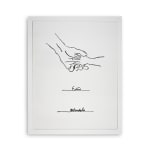Nelson Mandela
Struggle Series, 2001
Six lithographs on white cotton paper & 301 Incisioni board
Each 25 5/8 x 19 3/4 in | 65.1 x 50.2 cm
Edition 229 of 750
Unsigned, numbered in pencil, HOM and Mandela's emboss
Further images
-
(View a larger image of thumbnail 1
)

-
(View a larger image of thumbnail 2
)

-
(View a larger image of thumbnail 3
)

-
(View a larger image of thumbnail 4
)

-
(View a larger image of thumbnail 5
)

-
(View a larger image of thumbnail 6
)

-
(View a larger image of thumbnail 7
)

-
(View a larger image of thumbnail 8
)

-
(View a larger image of thumbnail 9
)

-
(View a larger image of thumbnail 10
)

COA issued by Collette Gallery
About the Work
The Struggle Series consists of six lithograph prints created in 2001 by the renowned South African activist and former President Nelson Mandela. Five of these prints, titled Struggle, Imprisonment, Freedom, Unity, and Future, depict simple line drawings of hands in various symbolic gestures. The simplicity of these drawings is contrasted with the profound narratives they convey, with Mandela explaining his depiction of hands as a universal symbol of action, connection, bondage, and liberation.
In a handwritten note displayed on the sixth and final lithograph, Motivation, Mandela shares a deeply personal insight: "These sketches are not so much about my life as they are about my own country. I drew hands because they are powerful instruments; hands can hurt or heal, punish or uplift. They can also be bound, but a quest for righteousness can never be repressed. In time, we broke loose the shackles of injustice, we joined hands across social divides and national boundaries, between continents and over oceans, and now we look to the future, knowing that even if age makes us wiser guides, it is the youth that reminds us of love, of trust, and of the value of life. " This personal connection to the artwork adds a layer of emotional depth that resonates with the audience.
The Struggle Series, widely regarded as one of Mandela's most significant artistic contributions, is a testament to his enduring legacy. This series, consisting of an edition of 750 plate-signed, large-format works, was meticulously produced by Van Rienbeeck Press and published by "Touch of Mandela" in Cape Town in 2003. Each print, signed and numbered by Mandela, is a work of art in itself, printed on heavy wove paper and mounted on white 310 Incisioni board, featuring Mandela's embossed mark and the publisher's blindstamp.
The Struggle Series consists of six lithograph prints created in 2001 by the renowned South African activist and former President Nelson Mandela. Five of these prints, titled Struggle, Imprisonment, Freedom, Unity, and Future, depict simple line drawings of hands in various symbolic gestures. The simplicity of these drawings is contrasted with the profound narratives they convey, with Mandela explaining his depiction of hands as a universal symbol of action, connection, bondage, and liberation.
In a handwritten note displayed on the sixth and final lithograph, Motivation, Mandela shares a deeply personal insight: "These sketches are not so much about my life as they are about my own country. I drew hands because they are powerful instruments; hands can hurt or heal, punish or uplift. They can also be bound, but a quest for righteousness can never be repressed. In time, we broke loose the shackles of injustice, we joined hands across social divides and national boundaries, between continents and over oceans, and now we look to the future, knowing that even if age makes us wiser guides, it is the youth that reminds us of love, of trust, and of the value of life. " This personal connection to the artwork adds a layer of emotional depth that resonates with the audience.
The Struggle Series, widely regarded as one of Mandela's most significant artistic contributions, is a testament to his enduring legacy. This series, consisting of an edition of 750 plate-signed, large-format works, was meticulously produced by Van Rienbeeck Press and published by "Touch of Mandela" in Cape Town in 2003. Each print, signed and numbered by Mandela, is a work of art in itself, printed on heavy wove paper and mounted on white 310 Incisioni board, featuring Mandela's embossed mark and the publisher's blindstamp.









